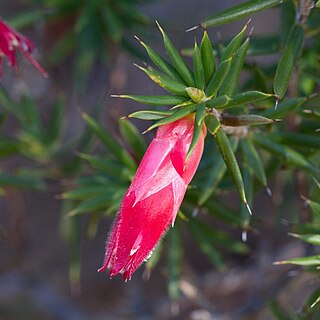
Stenanthera conostephioides, commonly known as flame heath, is a species of small shrub that is endemic to south-eastern continental Australia. It has linear to lance-shaped leaves, red, tubular flowers and green, oval fruit turning dark red.
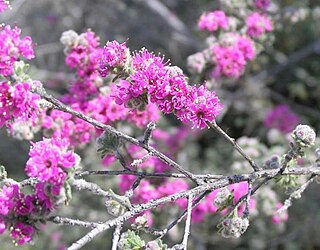
Kunzea preissiana is a flowering plant in the myrtle family, Myrtaceae, and is endemic to the southwest of Western Australia. It is a shrub with hairy branches and leaves, pink to mauve flowers in groups on the ends of shoots, and twenty to thirty stamens about the same length as the petals. It is a widespread, often locally common species across its range.
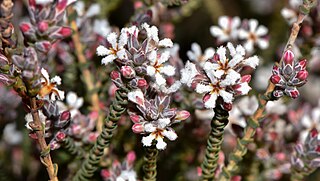
Leucopogon sprengelioides is a species of flowering plant in the family Ericaceae, and is endemic to the south-west of Western Australia. It is an erect shrub with stem-clasping, egg-shaped or lance-shaped leaves and short, dense spikes of white, tube-shaped flowers.

Leucopogon pulchellus, commonly known as beard-heath, is a species of flowering plant in the family Ericaceae, and is endemic to the south west of Western Australia. It is an erect or straggling shrub with erect, linear leaves and short, dense spikes of white, tube-shaped flowers.

Styphelia planifolia is a species of flowering plant in the heath family Ericaceae and is endemic to the south-west of Western Australia. It is a bushy shrub with narrowly oblong or lance-shaped leaves with a small, sharp point on the tip, and white, tube-shaped flowers.
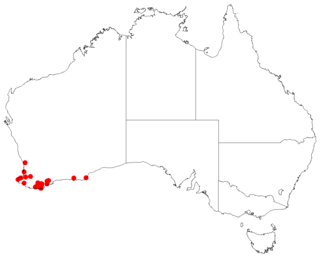
Leucopogon elatior is a species of flowering plant in the heath family Ericaceae and is endemic to the south-west of Western Australia. It is a slender, erect or straggly shrub with broadly egg-shaped leaves, and white, tube-shaped flowers.
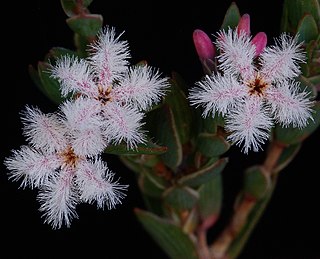
Leucopogon elegans is a species of flowering plant in the heath family Ericaceae and is endemic to the south-west of Western Australia. It is a spreading shrub with egg-shaped leaves, and white or pink, tube-shaped flowers densely bearded on the inside.

Leucopogon flavescens is a species of flowering plant in the heath family Ericaceae and is endemic to the south-west of Western Australia. It is a shrub with oblong leaves and white, tube-shaped flowers that are densely bearded on the inside.
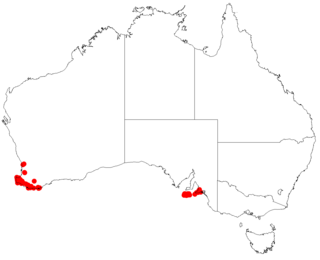
Leucopogon hirsutus is a species of flowering plant in the heath family Ericaceae and is endemic to southern continental Australia. It is a low-lying or straggling shrub with elliptic to oblong leaves and inconspicuous, white, bell-shaped flowers.
Thomasia discolor is a species of flowering plant in the family Malvaceae and is endemic to the south-west of Western Australia. It is a small, compact shrub with hairy new growth, heart-shaped leaves with wavy, lobed edges, and pink flowers in crowded clusters.

Conostephium preissii is a species of flowering plant in the family Ericaceae and is endemic to the southwest of Western Australia. It is an erect shrub with many stems, egg-shaped to oblong leaves and white and purplish to reddish-pink flowers.
Thomasia rulingioides is a species of flowering plant in the family Malvaceae and is endemic to the south-west of Western Australia. It is an erect, open shrub with densely hairy new growth, narrowly oblong to narrowly egg-shaped leaves with wavy edges, and pink to purple flowers.

Leucopogon obtusatus is a species of flowering plant in the heath family Ericaceae and is endemic to the south-west of Western Australia. It is an erect shrub that typically grows to a height of 0.25–1 m. Its leaves are sessile, egg-shaped to oblong, overlap each other and are about 2 mm (0.079 in) long. The flowers are arranged in short, dense spikes on the ends of branches or in upper leaf axils with leaf-like bracts and broad bracteoles less than half as long as the sepals. The sepals are about 2 mm (0.079 in) long, the petals about 4 mm (0.16 in) long and joined at the base, the lobes shorter than the petal tube.

Leucopogon oppositifolius is a species of flowering plant in the heath family Ericaceae and is endemic to the south of Western Australia. It is a slender, erect to spreading shrub that typically grows to a height of 15–80 cm (5.9–31.5 in). Its leaves are arranged in opposite pairs, narrowly linear to narrowly lance-shaped and 2–4 mm (0.079–0.157 in) long. The flowers are arranged in short spikes on the ends of branches with leaf-like bracts and narrow bracteoles about half as long as the sepals. The sepals are about 2 mm (0.079 in) long and lance-shaped, the petals about 4 mm (0.16 in) long and joined at the base, the lobes about the same length as the petal tube. Flowering mainly occurs from July to December.
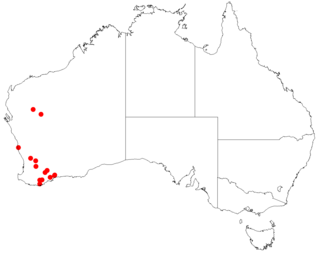
Leucopogon ovalifolius is a species of flowering plant in the heath family Ericaceae and is endemic to the south-west of Western Australia. It is an erect or straggling shrub that typically grows to a height of 1–2 ft (0.30–0.61 m). Its leaves are egg-shaped with the narrower end towards the base, 4.2–6.3 mm (0.17–0.25 in) long and sessile. The flowers are arranged in pairs or threes in leaf axils on a short peduncle with tiny bracts, and bracteoles less than half as long as the sepals. The sepals are about 2 mm (0.079 in) long, the petals 4.2–5.3 mm (0.17–0.21 in) long and joined at the base, the lobes longer than the petal tube.
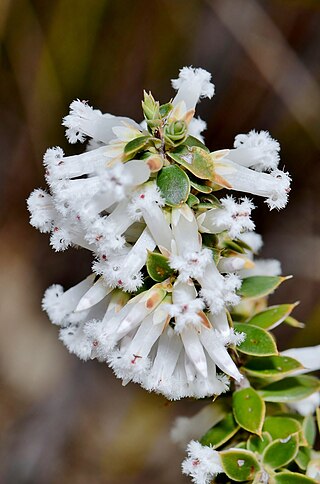
Leucopogon oxycedrus is a species of flowering plant in the heath family Ericaceae and is endemic to the south-west of Western Australia. It is an erect shrub with variably-shaped leaves with a small, sharp point on the tip, and white, pink or red, tube-shaped flowers.
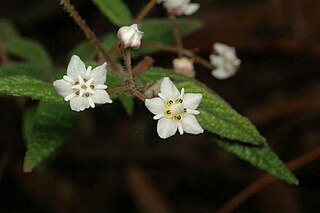
Commersonia rugosa is a species of flowering plant in the family Malvaceae and endemic to New South Wales. It is an open, straggly shrub with linear to narrowly egg-shaped leaves with irregular teeth or lobes on the edges, and white flowers in clusters of 3 to 15.
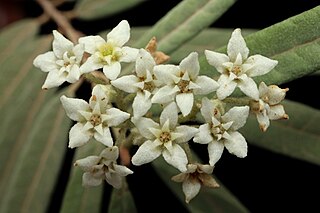
Commersonia salviifolia is a species of flowering plant in the family Malvaceae and endemic to eastern Australia. It is a shrub with lance-shaped leaves and white flowers in clusters of 5 to 30.
Pimelea villifera is a species of flowering plant in the family Thymelaeaceae and is endemic to the south-west of Western Australia. It is an erect, dense shrub usually with linear to narrowly elliptic leaves arranged in opposite pairs, and compact heads of many white flowers usually surrounded by 6 to 10 pairs of green and yellowish, narrowly egg-shaped involucral bracts.

Leucopogon tetragonus is a species of flowering plant in the family Ericaceae, and is endemic to the south of Western Australia. It is a robust shrub with crowded, often decussate, oblong to lance-shaped leaves and short, dense spikes of white, tube-shaped flowers.


















